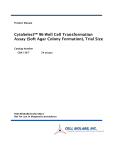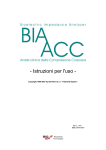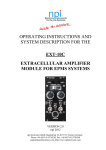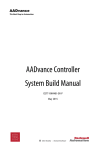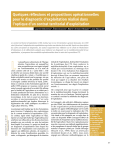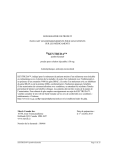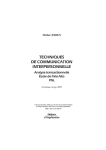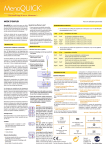Download Anti-DC (OX62) MicroBeads
Transcript
Anti-DC (OX62) MicroBeads rat Magnetic cell sorting Order No. 130-090-663 Index Examples of applications 1. ● Description Positive selection or depletion of dendritic cells from single-cell suspensions of lymphoid or non-lymphoid tissue, or peripheral blood.8 1.1 Principle of MACS® separation 1.2 Background and product applications 1.3 Reagent and instrument requirements 2. 1.3 Reagent and instrument requirements Buffer (degassed): Prepare a solution containing PBS (phosphate buffered saline) pH 7.2, 0.5% BSA and 2 mM EDTA by diluting MACS BSA Stock Solution (#130-091-376) 1:20 in autoMACS™ Rinsing Solution (# 130-091-222). Keep buffer cold (4−8 °C). ● Protocol 2.1 Sample preparation 2.2 Magnetic labeling ▲ Note: EDTA can be replaced by other supplements such as anticoagulant citrate dextrose formula-A (ACD-A) or citrate phosphate dextrose (CPD). BSA can be replaced by other proteins such as rat serum albumin, rat serum or fetal calf serum. Buffers or media containing Ca2+ or Mg2+ are not recommended for use. 2.3 Magnetic separation 3. Example of a separation using Anti-DC (OX62) MicroBeads 4. Appendix 5. References MACS Columns and MACS Separators: OX62+ cells can be enriched by using MS, LS or XS Columns (positive selection). Anti-DC (OX62) MicroBeads can be used for depletion of OX62+ cells on LD, CS or D Columns. Cells which strongly express the OX62 antigen can also be depleted using MS, LS or XS Columns. Positive selection or depletion can also be performed by using the autoMACS Separator. ● 1. Description Components 2 mL Anti-DC (OX62) MicroBeads, rat: MicroBeads conjugated to monoclonal mouse anti-DC (OX62) antibodies (isotype: mouse IgG1; clone: OX62). Size For 109 total cells, up to 100 separations. Product format The product is supplied as suspension containing 0.1% gelatine and 0.05% sodium azide. Storage Store protected from light at 4−8 °C. Do not freeze. The expiration date is indicated on the vial label. Column Separator Positive selection 1.1 Principle of MACS® separation First the OX62+ cells are magnetically labeled with Anti-DC (OX62) MicroBeads. Then the cell suspension is loaded onto a MACS® Column which is placed in the magnetic field of a MACS Separator. The magnetically labeled OX62+ cells are retained on the column. The unlabeled cells run through and this cell fraction is depleted of OX62+ cells. After removal of the column from the magnetic field, the magnetically retained OX62+ cells can be eluted as the positively selected cell fraction. MS 107 2 ×108 MiniMACS, OctoMACS, VarioMACS, SuperMACS LS 108 2 ×109 MidiMACS, QuadroMACS, VarioMACS, SuperMACS XS 109 2 ×1010 SuperMACS LD 108 5 ×108 MidiMACS, QuadroMACS, VarioMACS, SuperMACS CS 2 ×108 D 109 Depletion VarioMACS, SuperMACS SuperMACS Positive selection or depletion autoMACS 1.2 Background and product applications Anti-DC (OX62) MicroBeads are developed for the positive selection or depletion of OX62+ dendritic cells (DC) from blood, lymphoid and non-lymphoid tissue. The monoclonal antibody clone OX62 recognizes the integrin αE2 subunit1 (molecular mass 150 kDa)2 expressed on dendritic cells in the rat. Notably, OX62 antigen is found on both CD4+ OX41+ and CD4- OX41- dendritic cells.3,4,5 The OX62 antigen was also shown to be expressed on MHC II- TCRγ/δ+ T cells1, and on a subset of folliculo-stellate like (S100+) cells in the anterior pituitary6,7. OX62 is not detectable on Langerhans cells.1 max. number max. number of labeled cells of total cells 2 ×108 4 ×109 autoMACS ▲ Note: Column adapters are required to insert certain columns into VarioMACS™ Separator or SuperMACS™ Separator. For details, see MACS Separator data sheets. ● Collagenase D: 2 mg/mL Collagenase D (>0.15 U/ mg, e.g. from Roche, Germany) in RPMI/ 1% FCS. ● (Optional) Nycodenz®-PBS solution. Nycodenz® (from Nycomed As, Oslo, Norway) solubilized in PBS buffer at a final concentration of 14.5% (w/v). ● (Optional) Fluorochrome-conjugated Anti-DC (OX62) antibody for flow-cytometric analysis. 140-000-581.02 www.miltenyibiotec.com Miltenyi Biotec GmbH Friedrich-Ebert-Str. 68 51429 Bergisch Gladbach, Germany Phone +49-2204-8306-0 Fax +49-2204-85197 Miltenyi Biotec Inc. 12740 Earhart Avenue, Auburn CA 95602, USA Phone 800 FOR MACS, 530 888-8871 Fax 530 888-8925 page 1/4 Order No. 130-090-663 ● (Optional) PI (propidium iodide) or 7-AAD for flow-cytometric exclusion of dead cells. ● (Optional) Pre-Separation Filters (# 130-041-407) to remove cell clumps. 2. Protocol 2.1 Sample preparation Prepare a single-cell suspension from lymphoid organs, non-lymphoid tissue or peripheral blood using standard methods (see "General Protocols" in the User Manuals or visit www.miltenyibiotec.com/ protocols). ▲ Note: Dead cells may bind non-specifically to MACS MicroBeads. In case of high numbers of dead cells, removal of dead cells by density gradient centrifugation or the Dead Cell Removal Kit (# 130-090-101) is recommended. Preparation of rat spleens with Collagenase D To increase the recovery and final purity of dendritic cells, it is recommended to prepare spleen cell suspensions by Collagenase D treatment: 1. Place up to 2 isolated spleens in a 6 cm petri-dish with sufficient Collagenase D to completely cover the bottom of the dish (about 5 mL). 2. Inject spleens with 500 µL of Collagenase D per spleen using a 1 mL syringe and a 25G needle and cut the tissue in smaller pieces using a pair of scissors and a pair of forceps. 2.2 Magnetic labeling ▲ Work fast, keep cells cold, and use pre-cooled solutions. This will prevent capping of antibodies on the cell surface and non-specific cell labeling. ▲ Volumes for magnetic labeling given below are for up to 107 total cells. When working with fewer than 107 cells, use the same volumes as indicated. When working with higher cell numbers, scale up all reagent volumes and total volumes accordingly (e.g. for 2×107 total cells, use twice the volume of all indicated reagent volumes and total volumes). ▲ For optimal performance it is important to obtain a singlecell suspension before magnetic separation. Pass cells through 30 µm nylon mesh (Pre-Separation Filters # 130-041-407) to remove cell clumps which may clog the column. 1. Determine cell number. 2. Centrifuge cell suspension at 300×g for 10 minutes. Pipette off supernatant completely. 3. Resuspend cell pellet in 80 µL of buffer per 107 total cells. 4. Add 20 µL of Anti-Rat DC (OX62) MicroBeads per 107 total cells. 5. Mix well and incubate for 15 minutes at 4−8 °C. ▲ Note: Working on ice may require increased incubation times. Higher temperatures and/or longer incubation times lead to non-specific cell labeling. 3. Incubate spleen pieces for 25 minutes at 37 °C in Collagenase D. Add 10 mM EDTA and incubate a further 5 minutes. 6. 4. Pass the digested material through a steel mesh using a plunger of a syringe and wash the petri-dish and the mesh with buffer. (Optional) Add staining antibodies and incubate for 5 minutes at 4−8 °C. 7. Wash cells by adding 1−2 mL of buffer per 107 cells and centrifuge at 300×g for 10 minutes. Pipette off supernatant completely. 8. Resuspend up to 108 cells in 500 µL of buffer. 5. Pass all cells through a Pre-Separation Filters (# 130-041-407) to remove clumps and collect cells in a 50 mL tube. Add buffer to a final volume of about 50 mL. 6. Wash cells by centrifugation at 200×g for 10 minutes. Count cells. ▲ Note: For higher cell numbers, scale up buffer volume accordingly. ▲ Note: For depletion with LD Columns, resuspend up to 1.25×108 cells in 500 µL of buffer. 9. Proceed to magnetic separation (2.3). 7. Proceed to Nycodenz gradient centrifugation or magnetic labeling (2.2) (Optional) Pre-enrichment of rat dendritic cells by Nycodenz® gradient centrifugation For highly pure dendritic cells, OX62+ CD3+ TCR γ/δ+ T cells might be depleted prior to OX62 separation by Nycodenz® gradient centrifugation. 1. After centrifugation remove supernatant completely and resuspend cell pellet in 1 mL of buffer per 1−2×108 total cells. For fewer cells, use same volume. 2. Layer cell suspension on equal volume of 14.5% (w/v) Nycodenz-PBS solution (1.079 g/mL) and centrifuge for 13 minutes at 1,800×g and 4 °C. 3. Recover the low density cells at the top of the low density solution. Add buffer to a final volume of 50 mL and wash cells by centrifugation for 10 minutes at 200×g and 4 °C. Count cells. 2.3 Magnetic separation ▲ Choose an appropriate MACS Column and MACS Separator according to the number of total cells and the number of OX62+ cells (see table in section 1.3). Magnetic separation with MS or LS Columns 140-000-581.02 1. Place column in the magnetic field of a suitable MACS Separator (see "Column data sheets"). 2. Prepare column by rinsing with appropriate amount of buffer: MS: 500 µL LS: 3 mL. 3. Apply cell suspension onto the column. 4. Collect unlabeled cells which pass through and wash column with appropriate amount of buffer. Perform washing steps by adding buffer three times, each time once the column reservoir is empty. MS: 3×500 µL LS: 3×3 mL. Collect total effluent. This is the unlabeled cell fraction. www.miltenyibiotec.com This MACS® product is for in vitro research use only and not for diagnostic or therapeutic procedures. page 2/4 Order No. 130-090-663 5. Remove column from the separator and place it on a suitable collection tube. 3. Example of a separation using Anti-DC (OX62) MicroBeads 6. Pipette appropriate amount of buffer onto the column. Immediately flush out fraction with the magnetically labeled cells by firmly applying the plunger supplied with the column. MS: 1 mL LS: 5 mL. Dendritic cells were pre-enriched by Nycodenz gradient centrifugation from rat spleen cell suspension and were then isolated using Anti-DC (OX62) MicroBeads and a MiniMACS™ Separator with an MS Column. For flow cytometric analysis, cells were stained for OX62 and MHC Class II (OX6). Cell debris and dead cells were excluded from the analysis based on scatter signals and PI fluorescence. Magnetic separation with XS Columns For instructions on the column assembly and the separation, refer to the "XS Column data sheet". Rat spleen cells before separation 1. Place LD Column in the magnetic field of a suitable MACS Separator (see "LD Column data sheet"). 2. Prepare column by rinsing with 2 mL of buffer. 3. Apply cell suspension onto the column. 4. Collect unlabeled cells which pass through and wash column with 2×1 mL of buffer. Collect total effluent. This is the unlabeled cell fraction. OX62-APC Depletion with LD Columns Isolated dendritic cells OX62-APC ▲ Note: To increase the purity of the magnetically labeled fraction, it can be passed over a new, freshly prepared column. OX6-FITC OX6-FITC 1. Assemble CS Column and place it in the magnetic field of a suitable MACS Separator (see "CS Column data sheet"). 2. Prepare column by filling and rinsing with 60 mL of buffer. Attach a 22G flow resistor to the 3-way-stopcock of the assembled column (see "CS Column data sheet"). 3. Apply cell suspension onto the column. 4. Collect unlabeled cells which pass through and wash column with 30 mL buffer from the top. Collect total effluent. This is the unlabeled cell fraction. To evaluate the depletion of OX62+CD3+TCR γ/δ T cells from rat spleen by Nycodenz-preparation followed by MACS Technology, a sample of the isolated dendritic cells was stained with CD3-PE. OX62-FITC Depletion with CS Columns CD3-PE For instructions on column assembly and separation, refer to the "D Column data sheet". Magnetic separation with the autoMACS™ Separator ▲ Refer to the "autoMACS™ User Manual" for instructions on how to use the autoMACS Separator. 1. Prepare and prime autoMACS Separator. 2. Place tube containing the magnetically labeled cells in the autoMACS Separator. For a standard separation, choose following separation programs: To distinguish between the two major OX62+ dendritic cells subsets a sample of the isolated dendritic cells was additionally stained for CD4 (OX35). Note that OX62bright dendritic cells are CD4-, whereas OX62dim cells are CD4+. OX62-APC Depletion with D Columns CD4(OX35)-FITC Positive selection: "Possel" Depletion: "Depletes" ▲ Note: Program choice depends on the isolation strategy, the strength of magnetic labeling and the frequency of magnetically labeled cells. For details see autoMACS User Manual: "autoMACS Cell Separation Programs". 3. When using the program "Possel", collect positive fraction (outlet port "pos1"). This is the purified OX62+ cell fraction. 140-000-581.02 When using the program "Depletes", collect unlabeled fraction (outlet port "neg1"). This is the OX62- cell fraction. www.miltenyibiotec.com This MACS® product is for in vitro research use only and not for diagnostic or therapeutic procedures. page 3/4 Order No. 130-090-663 5. References 1. Brenan, M; Rees, JG (1997) Sequence analysis of rat integrin αE1and αE2 subunits. tissue expression reveals phenotypic similarities between intraepithelial lymphoctes and dendritic cells in lymph. Eur. J. Immunol. 27: 3070-3079. [957] 2. Brenan, M; Puklavec, M (1992) The MRC OX-62 Antigen: A Useful Marker in the Purification of Rat Veiled Cells with the Biochemical Properties of an Integrin. J. Exp. Med. 175: 1457-1465. [14] 3. Huang, F-P; Platt, N; Wykes, M; Major, JR; Powell, TJ; Jenkins, CD; MacPherson, GG (2000) A Discrete Subpopulation of Dendritic Cells Transports Apoptotic Intestinal Epithelial Cells to T Cell Areas of Mesenteric Lymph Nodes. J. Exp. Med. 191: 435-443. [953] 4. Trinité, B; Voisine, C; Yagita, H; Josien, R (2000) A Subset of Cytolytic Dendritic Cells in Rat. J. Immunol. 165: 4202-4208. [955] 5. Liu, L; Zhang, M; Jenkins, C; MacPherson, GG (1998) Dendritic Cell Heterogenity In Vivo: Two Functionally Different Dendritic Cell Populations in Rat Intestinal Lymph Can Be Distinguished by CD4 Expression. J. Immunol. 161: 1146-1155. 6. Allaerts, W; Jeucken, PHM; Debets, R; Hoefakker, S; Claassen, E; Drexhage, HA (1997) Heterogeneity of Pituitary Folliculo-Stellate Cells: Implications for Interleukin-6 Production and Accessory Function in vitro. J. Neuroendocrinol. 9: 43-53. [956] 7. Allaerts, W; Salomon, B; Leenen, PJM; van Wijngaardt, S; Jeucken, PHM; Ruuls, S; Klatzmann, D; Drexhage, HA (1997) A population of interstitial cells in the anterior pituitary with a hematopoietic origin and a rapid turnover: a relationship with folliculo-stellate cells? J. Neuroimmunol. 78: 184-197. 8. Kobayashi H, Miura S, Nagata H, Tsuzuki Y, Hokari R, Ogino T, Watanabe C, Azuma T, Ishii H. (2004) In situ demonstration of dendritic cell migration from rat intestine to mesenteric lymph nodes: relationships to maturation and role of chemokines. J. Leukoc. Biol. 75(3): 434-42. [3995] Warnings Reagents contain sodium azide. Under acidic conditions sodium azide yields hydrazoic acid, which is extremely toxic. Azide compounds should be diluted with running water before discarding. These precautions are recommended to avoid deposits in plumbing where explosive conditions may develop. Warranty The products sold hereunder are warranted only to be free from defects in workmanship and material at the time of delivery to the customer. MILTENYI BIOTEC GmbH makes no warranty or representation, either expressed or implied, with respect to the fitness of a product for a particular purpose. There are no warranties, expressed or implied, which extend beyond the technical specifications of the products. MILTENYI BIOTEC GmbH’s liability is limited to either replacement of the products or refund of the purchase price. MILTENYI BIOTEC GmbH is not liable for any property damage, personal injury or economic loss caused by the product. MACS® is a registered trademark of Miltenyi Biotec GmbH. 140-000-581.02 www.miltenyibiotec.com This MACS® product is for in vitro research use only and not for diagnostic or therapeutic procedures. page 4/4




